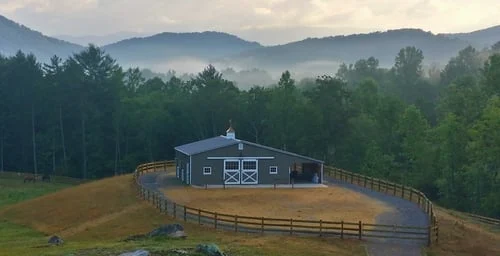Things to Consider Before Building a Low Profile Horse Barn
The low profile horse barn has emerged as a popular choice for both seasoned equestrians and newcomers to the horse world. Its sleek aesthetic, affordability, and ease of construction are just a few of the factors contributing to its growing appeal. However, before embarking on your low-profile barn journey, it’s crucial to carefully consider several key factors to ensure a functional and comfortable space for your horses.
Zoning Regulations and Permits Check Local Zoning Laws
Every region has its own zoning regulations regarding permissible structures. Contact your local building department or zoning office to understand the specific regulations for constructing a low-profile barn on your property. This includes aspects like building height limitations, setbacks from property lines, and potential permits required for construction.
Obtain Necessary Permits
Once you’ve familiarized yourself with the regulations, begin the process of obtaining any necessary permits. This may involve submitting plans, paying fees, and potentially undergoing inspections throughout the construction process. Failing to secure proper permits can lead to substantial fines and even project delays or stoppages.
Ventilation and Airflow Importance of Proper Ventilation
Adequate ventilation is essential for several reasons. It helps remove harmful dust, ammonia, and moisture generated by horses, creating a healthier environment for both animals and humans. Additionally, proper airflow prevents condensation buildup that can lead to mold growth and structural damage.
Natural Ventilation Strategies
Low-profile barns present a unique challenge in terms of ventilation due to their limited height. However, there are several strategies to consider.
Roof vents
Installing strategically placed roof vents allows warm, stale air to escape, creating a natural airflow throughout the barn.
Cross-ventilation
Utilize strategically placed windows and doors on opposing walls to facilitate cross-ventilation, drawing fresh air into the barn and pushing out stale air.
Mechanical Ventilation Systems
Depending on the specific climate and number of horses housed, supplementing natural ventilation with exhaust fans may be necessary. Consult an experienced barn builder or veterinarian to determine if and where to install exhaust fans for optimal air circulation.
Stall Design and Comfort Minimum Stall Size Requirements
While local regulations may not specify minimum stall size, adhering to recommended guidelines from organizations like the American Association of Equine Practitioners (AAEP) is crucial for your horse’s well-being. The AAEP recommends a minimum stall size of 12′ x 12′ for an average-sized horse. Consider future needs and adjust accordingly if you plan on housing larger breeds or multiple horses per stall.
Stall Flooring
Choose a comfortable and durable flooring material for your horse’s stall. Popular options include rubber mats, concrete, and compacted gravel. Rubber mats provide excellent comfort and are easy to clean, while concrete is highly durable but can be cold and slippery. Compacted gravel is budget-friendly but requires regular maintenance to prevent mud formation and uneven surfaces.
Stall Walls and Doors
Opt for smooth, sturdy materials for stall walls, such as wood, metal panels, or concrete. Avoid sharp edges or protruding objects that could injure your horse. Choose safe and reliable stall doors that allow easy access while ensuring the horse remains securely contained. Consider the type of door you prefer, such as sliding doors, swinging doors, or Dutch doors (divided doors offering upper ventilation).
Storage Solutions Maximize Vertical Space
Low-profile barns often have limited floor space. Utilize the vertical space efficiently by installing hay lofts above the stalls or tack rooms. Ensure the loft structure is strong enough to safely support the weight of hay bales and is easily accessible for loading and unloading.
Utilize Wall Space
Consider installing wall-mounted cabinets, shelves, or pegboards to organize your tack, cleaning supplies, and other equipment. This will keep them neat and readily accessible, preventing clutter within the horse stalls or walkways.
Dedicated Storage Shed
If additional storage space is a concern, consider constructing a separate storage shed adjacent to the barn. This can house bulkier items like farm equipment, manure bins, or extra bedding.
Additional Considerations Drainage
Ensure proper drainage around the barn to prevent water pooling and potential flooding. This might involve grading the land, installing drainage ditches, or utilizing French drains to divert water away from the foundation.
Lighting
Provide adequate lighting within the barn and around the exterior walkways for safety and ease of operation, especially during evening hours. Choose energy-efficient options such as LED lights to reduce long-term energy costs.
Water Access
Ensure convenient access to clean water for your horses. Install automatic waterers within each stall or a centralized water trough in a dedicated area.
Electrical Wiring
Have a qualified electrician install electrical wiring throughout the barn to power lights, ventilation systems, and any additional equipment you plan to use. Ensure proper safety measures are followed, including appropriate outlets and grounding systems.
Choosing a Builder Research and Compare
Once you’ve navigated the initial considerations, it’s time to find a reputable builder to turn your vision into reality. Research local barn builders, obtain references, and compare their experience, expertise, and portfolio of past projects, particularly those focusing on low-profile barns.
Ask Questions and Understand the Process
Discuss your specific needs and requirements with potential builders. Ask detailed questions about their construction methods, materials used, warranty terms, and estimated timelines. Understand the entire building process, including any subcontracting involved and communication protocols throughout the project.
Budgeting and Financing Develop a Detailed Budget
Create a comprehensive budget encompassing all anticipated costs, including building materials, labor, permits, foundation work, and any additional features like tack rooms or wash stalls. Include a buffer for unforeseen expenses that may arise during construction.
Explore Financing Options
If necessary, explore financing options to manage the upfront costs of building your low-profile barn. Consider loans from banks, agricultural lenders, or equipment financing companies. Carefully compare interest rates, repayment terms, and any associated fees before making a decision.
Maintaining Your Low-Profile Barn Regular Inspections and Maintenance
Schedule regular inspections of the roof, foundation, and ventilation system for any signs of damage or wear and tear. Address any issues promptly to maintain the structural integrity and functionality of your barn.
Cleaning and Sanitation
Maintain a clean and hygienic environment within the barn by regularly removing manure and bedding, and thoroughly cleaning stalls, walkways, and equipment. This minimizes the risk of disease and maintains a healthy atmosphere for your horses.
Pest Control
Implement preventative measures to control pests like rodents and insects. This may involve sealing potential entry points, using appropriate traps or baits, and maintaining a clean environment that discourages their presence.
Conclusion
Building a low-profile horse barn can be an exciting and rewarding project, providing a comfortable and functional space for your horses. By carefully considering the various factors discussed above, you can ensure a smooth and successful journey from planning to construction and, ultimately, create a long-lasting haven for your equine companions. Remember, consulting with experienced professionals like barn builders, veterinarians, and local authorities can provide valuable insights and guidance throughout the process.








